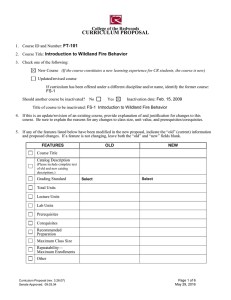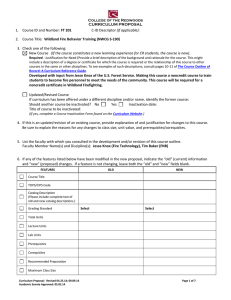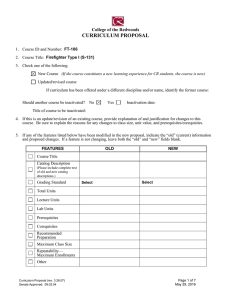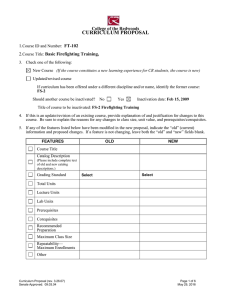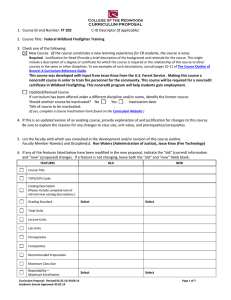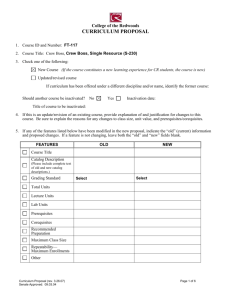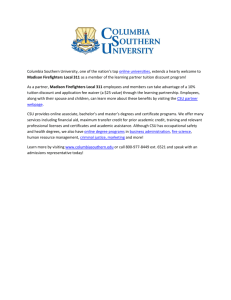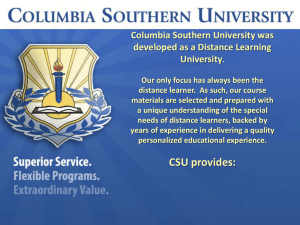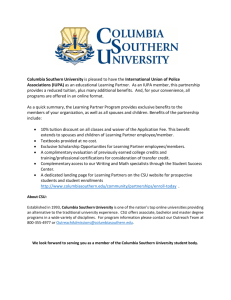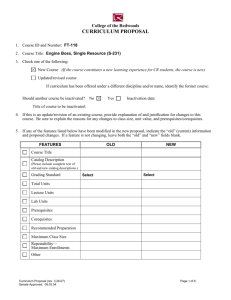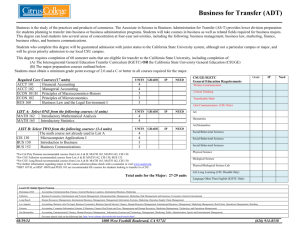FT-109_01.23.09
advertisement
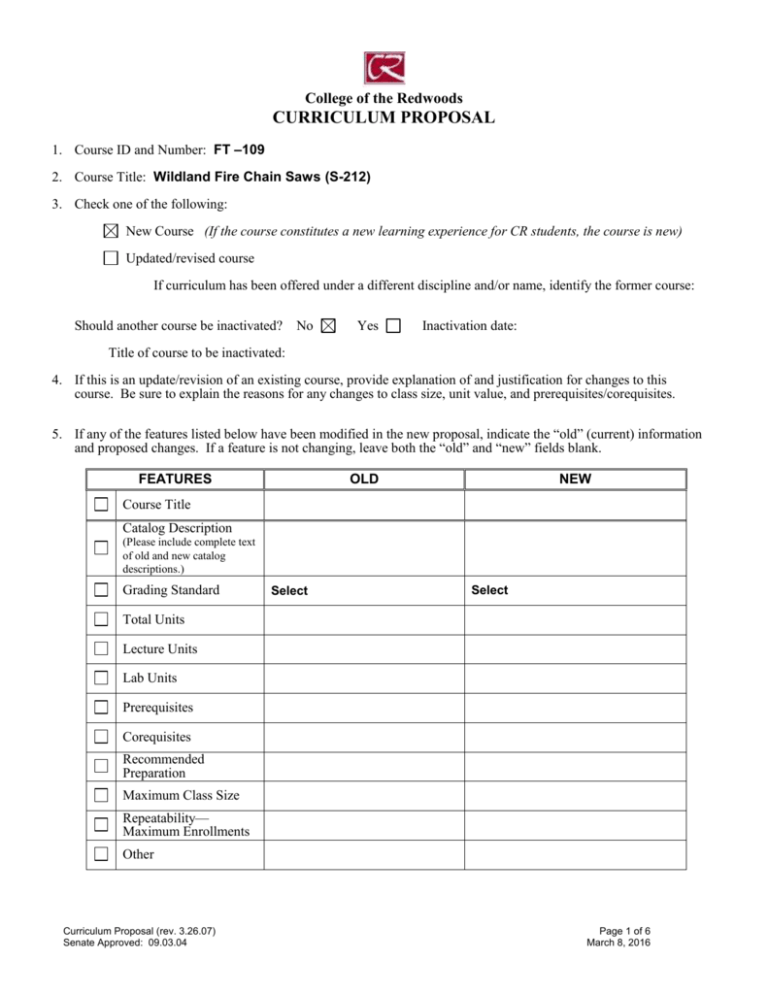
College of the Redwoods CURRICULUM PROPOSAL 1. Course ID and Number: FT –109 2. Course Title: Wildland Fire Chain Saws (S-212) 3. Check one of the following: New Course (If the course constitutes a new learning experience for CR students, the course is new) Updated/revised course If curriculum has been offered under a different discipline and/or name, identify the former course: Should another course be inactivated? No Yes Inactivation date: Title of course to be inactivated: 4. If this is an update/revision of an existing course, provide explanation of and justification for changes to this course. Be sure to explain the reasons for any changes to class size, unit value, and prerequisites/corequisites. 5. If any of the features listed below have been modified in the new proposal, indicate the “old” (current) information and proposed changes. If a feature is not changing, leave both the “old” and “new” fields blank. FEATURES OLD NEW Course Title Catalog Description (Please include complete text of old and new catalog descriptions.) Grading Standard Select Select Total Units Lecture Units Lab Units Prerequisites Corequisites Recommended Preparation Maximum Class Size Repeatability— Maximum Enrollments Other Curriculum Proposal (rev. 3.26.07) Senate Approved: 09.03.04 Page 1 of 6 March 8, 2016 College of the Redwoods COURSE OUTLINE 1. DATE: Jan 13, 2009 2. DIVISION: Public Safety Center 3. COURSE ID AND NUMBER: FT-109 4. COURSE TITLE (appears in catalog and schedule of classes): Wildland Fire Chain Saws (NWCG S-212) 5. SHORT TITLE (appears on student transcripts; limited to 30 characters, including spaces): S-212 Chain Saws 6. LOCAL ID (TOPS): 2133.10 (Taxonomy of Program codes http://www.cccco.edu/Portals/4/AA/CP%20&%20CA3/TopTax6_rev_07.doc) 430203 (Classification of Instructional Program codes can be found in Appendix B of the TOPS code book http://www.cccco.edu/Portals/4/AA/CP%20&%20CA3/TopTax6_rev_07.doc) 7. NATIONAL ID (CIP): 8. Discipline(s) (Select from CCC System Office Minimum Qualification for Faculty [copy following web address and paste into web browser http://www.cccco.edu/divisions/esed/aa_ir/psmq/min_qual/min_quals%20_revApr406.pdf] Course may fit more than one discipline; identify all that apply): Fire Technology 9. FIRST TERM NEW OR REVISED COURSE MAY BE OFFERED: 10. TOTAL UNITS: TOTAL HOURS: 1.5 45 [Lecture Units: 1 Lab Units: [Lecture Hours: 18 Lab Hours: (1 unit lecture=18 hours; 1 unit lab=54 hours) .5] 27] 21 11. MAXIMUM CLASS SIZE: 12. WILL THIS COURSE HAVE AN INSTRUCTIONAL MATERIALS FEE? No Yes Fee: $ (If “yes,” attach a completed “Instructional Materials Fee Request Form”—form available in Public Folders>Curriculum>Forms) GRADING STANDARD Letter Grade Only Pass/No Pass Only Is this course a repeatable lab course: No Yes Grade-Pass/No Pass Option If yes, how many total enrollments? Is this course to be offered as part of the Honors Program? No Yes If yes, explain how honors sections of the course are different from standard sections. CATALOG DESCRIPTION -- The catalog description should clearly describe for students the scope of the course, its level, and what kinds of student goals the course is designed to fulfill. The catalog description should begin with a sentence fragment. Introduction to the function, maintenance and safe use of internal combustion engine powered chain saws and their tactical wildland fire applications. Field exercises support entry level training for firefighters with little or no previous experience in operating a chainsaw. Students will perform hands-on cutting experience in areas similar to fireline situations. This course provides required training for all wildland fire chain saw operator positions. Special notes or advisories (e.g. field trips required, prior admission to special program required, etc.): To enroll, students must be qualified as a Firefighter Type 2 (FFT2) and possess current certification in Basic First Aid and CPR. Upon successful completion and prior to using a chainsaw for wildland fire operations, students will be issued the appropriate agency card reflecting student’s skill level to use a chainsaw. PREREQUISITE COURSE(S) No Yes Rationale for Prerequisite: Curriculum Proposal (rev. 3.26.07) Senate Approved: 09.03.04 Course(s): Page 2 of 6 March 8, 2016 Describe representative skills without which the student would be highly unlikely to succeed. COREQUISITE COURSE(S) No Yes Rationale for Corequisite: Course(s): RECOMMENDED PREPARATION No Yes Course(s): Rationale for Recommended Preparation: COURSE LEARNING OUTCOMES –This section answers the question “what will students be able to do as a result of taking this course?” State some of the objectives in terms of specific, measurable student actions (e.g. discuss, identify, describe, analyze, construct, compare, compose, display, report, select, etc.). For a more complete list of outcome verbs please see Public Folders>Curriculum>Help Folder>SLO Language Chart. Each outcome should be numbered. 1. List, define, and apply chain saw safety standards as required by OSHA and NWCG member agency manuals, handbooks and directives. 2. Incorporate the approved use, maintenance, and function of personal protective equipment (PPE) in wildland fire chain saw applications. 3. Identify basic chain saw parts nomenclature, maintenance, tuning, troubleshooting, and safety features. 4. Demonstrate field maintenance tasks required for chain saw operation. 5. Demonstrate the tactical application of chain saws in brushing, limbing, bucking, and falling for fireline construction and mop up operations. COURSE CONTENT –This section describes what the course is “about”—i.e. what it covers and what knowledge students will acquire Each item should be numbered. Concepts: What terms and ideas will students need to understand and be conversant with as they demonstrate course outcomes? 1. Chain saw safety standards as required by OSHA, NWCG, agency manuals, handbooks and directives. 2. Familiarization with chain saw commonly used by student. 3. Performance of field maintenance tasks required for chain saw operation. 4. Tactical application of chain saws in brushing, limbing, bucking, and falling for fireline construction and mop up operations. 5. Job Hazard Analysis 6. Hazards (physical, biological, environmental, chemical and other). 7. Required personal protective equipment (PPE). 8. Maintenance of (PPE). 9. Situational awareness. Issues: What primary tensions or problems inherent in the subject matter of the course will students engage? 1. Ensuring required Personal Protective Equipment (PPE) is used. 2. Safety of self and others. Themes: What motifs, if any, are threaded throughout the course? 1. Effective and safe use of a chainsaw. 2. Maintenance of chainsaw. Skills: What abilities must students have in order to demonstrate course outcomes? (E.g. write clearly, use a scientific calculator, read college-level texts, create a field notebook, safely use power tools, etc.) 1. Use chain saw safely. 2. Start a chainsaw in the approved chainsaw starting method. 3. Demonstrate the ability to analyze and mitigate ground and overhead hazards. Curriculum Proposal (rev. 3.26.07) Senate Approved: 09.03.04 Page 3 of 6 March 8, 2016 4. Properly limb a standing tree to the height of the students head. 5. Properly cut and remove strips of brush to near ground level, six feet wide and twenty feet long. 6. Execute a specified horizontal bore cut through a specified stump. 7. Limb and buck a downed tree into specified lengths. 8. Size up. Prepare and fell a tree/snag up to twenty inched DBH in a specified direction. REPRESENTATIVE LEARNING ACTIVITIES –This section provides examples of things students may do to engage the course content (e.g., listening to lectures, participating in discussions and/or group activities, attending a field trip). These activities should relate directly to the Course Learning Outcomes. 1. Listening to lectures 2. Participating in group discussions and exercises 3. Using a chainsaw in a field exercise. ASSESSMENT TASKS –This section describes assessments instructors may use to allow students opportunities to provide evidence of achieving the Course Learning Outcomes. Representative assessment tasks (These are examples of assessments instructors could use): 1. Tests consisting of true/false, multiple choice and fill in the blank questions. 2. Demonstrate competency in safely brushing, bucking and falling. Required assessments for all sections (These are assessments that are required of all instructors of all sections at all campuses/sites. Not all courses will have required assessments. Do not list here assessments that are listed as representative assessments above.): 1. Participation in discussions and exercises. EXAMPLES OF APPROPRIATE TEXTS OR OTHER READINGS –This section lists example texts, not required texts. Author, Title, and Date Fields are required Author NWCG Title NFES 2000, S-212 Student Workbook Date Current Version Author NWCG Title NFES 2644, S-212 Precourse Work Date Current Version Author NWCG Title NFES 1077, Incident Response Pocket Guide Date Author Title Current Version Date Other Appropriate Readings: Agency approved Job Hazard Analyses COURSE TYPES 1. Is the course part of a Chancellor’s Office approved CR Associate Degree? No Yes If yes, specify all program codes that apply. (Codes can be found in Outlook/Public Folders/All Public Folders/ Curriculum/Degree and Certificate Programs/choose appropriate catalog year): Required course for degree(s) Restricted elective for degree (s) Restricted electives are courses specifically listed (i.e. by name and number) as optional courses from which students may choose to complete a specific number of units required for an approved degree. 2. Is the course part of a Chancellor’s Office approved CR Certificate of Achievement? No Yes If yes, specify all program codes that apply. ( Codes can be found in Outlook/Public Folders/All Public Folders/ Curriculum/Degree and Certificate Programs/choose appropriate catalog year): Required course for certificate(s) Restricted elective for certificate(s) Restricted electives are courses specifically listed (i.e. by name and number) as optional courses from which students may choose to complete a specific number of units required for an approved certificate. 3. Is the course Stand Alone? 4. Basic Skills: NBS Not Basic Skills 5. Work Experience: NWE Not Coop Work Experience Curriculum Proposal (rev. 3.26.07) Senate Approved: 09.03.04 No Yes (If “No” is checked for BOTH #1 & #2 above, the course is stand alone) Page 4 of 6 March 8, 2016 6. VATEA Funded Course (applies to vocational and tech-prep courses only): 7. Purpose: I Occupational Ed 8. Accounting Method: PAC Positive Attendance/CR 9. Disability Status: N Not a Special Class yes no CURRENT TRANSFERABILITY STATUS This course is currently transferable to Neither CSU nor UC CSU as general elective credit CSU as a specific course equivalent (see below) If the course transfers as a specific course equivalent, give course number(s)/ title(s) of one or more currently-active, equivalent lower division courses from CSU. 1. Course , Campus 2. Course , Campus UC as general elective credit UC as specific course equivalent If the course transfers as a specific course equivalent, give course number(s)/ title(s) of one or more currently-active, equivalent lower division courses from UC. 1. Course , Campus 2. Course , Campus PROPOSED CSU TRANSFERABILITY (If course is currently CSU transferable, go to the next section): None General Elective Credit Specific Course Equivalent (see below) If specific course equivalent credit is proposed, give course number(s)/ title(s) of one or more currently-active, equivalent lower division courses from CSU. 1. Course , Campus 2. Course , Campus PROPOSED UC TRANSFERABILITY (If course is currently UC transferable, go to the next section): None General Elective Credit OR Specific Course Equivalent (see below) If “General Elective Credit OR Specific Course Equivalent” box above is checked, give course number(s)/ title(s) of one or more currently-active, equivalent lower division courses from UC. 1. Course , Campus 2. Course , Campus CURRENTLY APPROVED GENERAL EDUCATION CR CSU IGETC CR GE Category: CSU GE Category: IGETC Category: PROPOSED CR GENERAL EDUCATION Rationale for CR General Education approval (including category designation): Natural Science Social Science Humanities Language and Rationality Writing Oral Communications Analytical Thinking Curriculum Proposal (rev. 3.26.07) Senate Approved: 09.03.04 Page 5 of 6 March 8, 2016 PROPOSED CSU GENERAL EDUCATION BREADTH (CSU GE) A. Communications and Critical Thinking B. Science and Math A1 – Oral Communication A2 – Written Communication A3 – Critical Thinking B1 – Physical Science B2 – Life Science B3 – Laboratory Activity B4 – Mathematics/Quantitative Reasoning C. Arts, Literature, Philosophy, and Foreign Language D. Social, Political, and Economic Institutions C1 – Arts (Art, Dance, Music, Theater) C2 – Humanities (Literature, Philosophy, Foreign Language) D0 – Sociology and Criminology D1 – Anthropology and Archeology D2 – Economics D3 – Ethnic Studies D5 – Geography D6 – History E. Lifelong Understanding and Self-Development D7 – Interdisciplinary Social or Behavioral Science E1 – Lifelong Understanding D8 – Political Science, Government and Legal Institutions E2 – Self-Development D9 – Psychology Rationale for inclusion in this General Education category: Same as above Proposed Intersegmental General Education Transfer Curriculum (IGETC) 1A – English Composition 1B – Critical Thinking-English Composition 1C – Oral Communication (CSU requirement only) 2A – Math 3A – Arts 3B – Humanities 4A – Anthropology and Archaeology 4B – Economics 4E – Geography 4F – History 4G – Interdisciplinary, Social & Behavioral Sciences 4H – Political Science, Government & Legal Institutions 4I – Psychology 4J – Sociology & Criminology 5A – Physical Science 5B – Biological Science 6A – Languages Other Than English Rationale for inclusion in this General Education category: Same as above Submitted by: Mike Wells Division Chair/Director: Mike Wells Tel. Ext. 4331 Review Date: 10/3/08 Approved by Curriculum Committee: No Academic Senate Approval Date: 2/6/9 CURRICULUM COMMITTEE USE ONLY Yes Date: 1.23.09 Board of Trustees Approval Date: 3.3.9 Curriculum Proposal (rev. 3.26.07) Senate Approved: 09.03.04 Date: 10/3/08 Page 6 of 6 March 8, 2016
